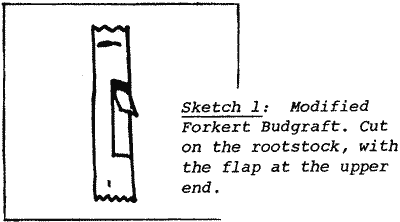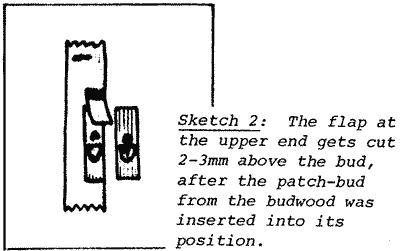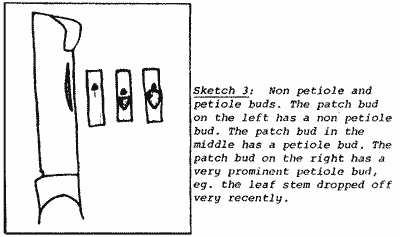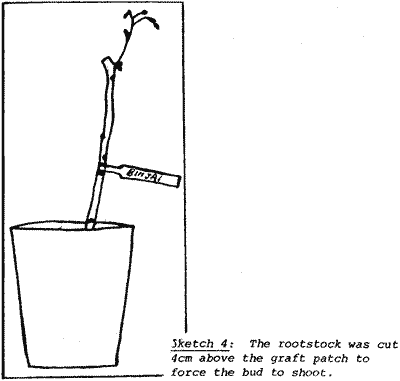
BUDGRAFTING OF RAMBUTAN SEEDLINGS IN THE DARWIN AREA
SCIENTIFIC NAME: Nephelium lappaceum
FAMILY: Sapindaceae
1. INTRODUCTlON
Rambutan trees are not true to type when grown from seeds. Seeds of a particular variety may produce male, hermaphrodite or female plants. In a commercial plantation, only high value, true-to-type varieties with good fruit quality are of interest.
True-to-type plants at present can only be produced through grafting of a seedling, or through propagation from marcots or perhaps cuttings.
The propagation of rambutan trees from marcots is not very successful in the Darwin area. The success rate is usually low. Thus only grafted rambutan seedlings are planted by commercial growers.
2. GRAFTING METHODS
Two main grafting methods apply:
a] approach grafting
b] budgrafting
Approach grafting is technically less demanding, the quality of the rootstocks is of lesser importance and the success rate is usually high. The disadvantage of approach grafting is its comparatively high labour requirement for building of scaffoldings and irrigation systems on the scionwood tree. The grafting itself too is more laborious when compared with budgrafting. The formation of a perfect union between scionwood and rootstock usually takes longer than in the case of a budgraft.
Approach grafting is a suitable grafting system if only a small number of rootstocks are involved. If a large number of rambutan rootstocks are to be grafted, then budgrafting becomes advantageous.
3. BUDGRAFTING OF RAMBUTANS
Two main budgrafting methods are used:
a] The modified Forkert Bud-Graft
b] The Punch Bud-Graft
Punch-budding of rambutans is a simple comparison, though some people have difficulties getting a suitable punch-tool.
Usually the "Modified Forkert Budgraft" is applied. This grafting method is executed with a conventional grafting knife and is used by a majority of nurserymen.
Between November 6th and May 19th of the following year a rambutan grafting trial was done 60 km east of Darwin, mainly to find out what time of the year is a good grafting time, and to research some minor grafting problems.
3.1 Materials and Methods in the Trial
a] The grafting method applied was always the "Modified Forkert Budgraft".

b] The "Modified Forkert Budgraft" was used with the flap at the upper end (see Sketch 1). The bud-patch was usually about 6mm wide and 20mm long. The width of the bud-patch was usually a third of the trunk circumference. The location of the bud on the patch was normally 6 - 7cm below the upper end of the patch.
c] The flap on the rootstock was cut first, then lifted and immediately put back into its original position, to prevent oxidations (a brown colouring of the wood underneath the lifted bark).
Then the bud patch was cut and removed from the budwood. The patch was immediately transferred and inserted underneath the already-cut flap on the rootstock.
The flap on the rootstock was usually cut to a length 2 - 3mm above the bud (see Sketch 2).

Then the graft was wrapped airtight with a grafting tape.
Only one bud-patch per rootstock was used at a time. If the bud died, the rootstock was re-grafted.
The grafting was always done inside a greenhouse, which was covered with rigid plastic and its sides closed with 50% shade cloth. Only one grafting was done in the plain sun at 47% relative humidity. The relative humidity inside the greenhouse was about 50 - 60% on sunny days, and above 60% on cloudy or rainy days.
In the greenhouse about 40 - 50% of the sunlight was shaded out.
f] The rootstocks were between 8 and 14 months old and grew vigorously in 2.5 litre bags. The potting mix contained 50% peatmoss and 50% coarse river sand. The minimum diameter of the rootstocks at the lower end was 7 - 8mm.
g] The grafting tape used was usually transparent. Only once a dark grafting tape was used to check the light influence on bud take.
h) None of the budwood was prepared. Usually buds from brown wood were used. Only once buds from grey wood were tested.
i] Petiole and non-petiole buds were used and, compared (see Sketch 3).

j] The rootstocks were initially sorted into those with a "new flush" and those with an "old flush".
k] The grafting tape was removed 3 weeks after grafting. To protect the grafting area from ants (they eat the bark) a 1-cm-wide ring of Chlordane solution was applied immediately above and beneath the graft.
l] 4 weeks after grafting, the first bud check was done. Clearly green buds were forced to shoot by cutting off the rootstock 4cm above the grafting patch (see Sketch 4).
Halfgreen patches were left for another check 6 weeks after grafting.
Any buds, which did not show signs of taking after 6 weeks from grafting, were removed and the rootstock was re-grafted another time.
It is important that the rootstock is not cut back, unless there are clear signs that the budgraft is taking.

The grafting was usually done between 10.30h and 15.30h. During this period the changes in relative humidity were usually only minor, between 5% and 7%.
4. RESULTS OF THE RAMBUTAN GRAFTING TRIAL
14 different rambutan varieties were in the trial. The grafting was done at 14 different dates. A total of 511 buds were grafted onto rootstocks and from these only 234 grew successfully, which means that the overall success rate was 45.8%. The grafting success rate at different times and for different varieties varied between 11% and 100%.
4.1 Petiole and non-petiole buds
There was no statistically significant difference in the grafting success rate, when petiole or non-petiole buds were used (see Table 1). 99 petiole buds showed a success rate of 59.7% and 84 non-petiole buds showed a success rate of 62.1%.
Table 1: Grafting success rate of petiole buds versus non-petiole buds.
| Variety | Type of Bud | No. Buds Grafted | % of Bud Take | Date of Grafting |
| Binjai | Non-Petiole | 11 | 81.81 | 13.11.86 |
| Binjai | Petiole | 11 | 90.90 | 13.11.86 |
| Rapiah | Non-Petiole | 15 | 53.33 | 20.11.86 |
| Rapiah | Petiole | 7 | 100.00 | 20.11.86 |
| Sileng Keng | Non-Petiole | 4 | 75.00 | 18.12.86 |
| Sileng Keng | Petiole | 8 | 75.00 | 18.12.86 |
| Bogor | Non-Petiole | 7 | 42.86 | 18.12.86 |
| Bogor | Petiole | 6 | 50.00 | 18.12.86 |
| Seenjen | Non-Petiole | 5 | 100.00 | 18.12.86 |
| Seenjen | Petiole | 5 | 80.00 | 18.12.86 |
| Jitt Lee | Non-Petiole | 21 | 71.53 | 24.12.86 |
| Jitt Lee | Petiole | 23 | 43.37 | 24.12.86 |
| Jitt Lee | Non-Petiole | 12 | 50.00 | 18.05.87 |
| Jitt Lee | Petiole | 26 | 23.08 | 18.05.87 |
| "134" | Non-Petiole | 9 | 22.22 | 18.05.87 |
| "134" | Petiole | 13 | 15.38 | 18.05.87 |
When petiole buds are used, it is important that the budwood is prepared on the tree sufficiently in advance, so that the leaf stem can drop off.
4.2 The influence of light intensity on bud take
The influence of light intensity on bud take was smaller than commonly assumed (see Table 2). In 2 small trials, 16 patch buds were wrapped with clear, light-transparent grafting tape and the grafting success rate was 63. 3%. 14 patch buds were wrapped with dark grafting tape and the success rate was 58.3%.
Table 2: Dark vs Clear Grafting Tape.
| Variety | Grafting Tape | Number of Buds Grafted | % of Bud Take | Date of Grafting |
| 134 | Clear | 6 | 66.67 | 31.12.86 |
| 134 | Dark | 6 | 66.67 | 31.12.86 |
| 161 | Clear | 10 | 60.00 | 31.12.86 |
| 161 | Dark | 8 | 50.00 | 31.12.86 |
4.3 Patch-bud from grey or brown budwood
The grafting quality of buds from differently aged wood was tested. Table 3 indicates that buds from grey budwood are all right. It is rather impractical to use grey patch-buds because it is difficult to remove them from the budwood. Patch buds from brown-wood can be handled much easier.
Table 3: Age Of Budwood And Its Grafting Quality.
| Variety | Budwood Colour | Age of Budwood | No. of Buds Grafted | % Buds Taken | Date of Grafting |
| 167 | Grey | Old | 6 | 50.0 | 06.11.86 |
| 167 | Brown | Young | 18 | 44.4 | 06.11.86 |
4.4 Rootstocks with old or new growth flushes
The difference in the grafting success rate between rootstocks, which at the time of grafting had a new growth flush or an old flush was statistically insignificant.
Table 4 shows that 67 rootstocks with a new growth flush at grafting time showed a success rate of 59.67% and 74 trees with an old growth flush had a success rate of 57.13%.
Table 4: Grafting Success Rates If Rootstocks With Old Or New Growth Flushes Were Used.
| Variety | Growth Flush | No. Buds Grafted | % Bud Take | Date of Grafting |
| 167 | New | 12 | 33.1 | 06.11.86 |
| 167 | Old | 12 | 50.0 | 06.11.86 |
| Binjai | New | 9 | 88.8 | 13.11.86 |
| Binjai | Old | 13 | 84.6 | 13.11.86 |
| Rapiah | New | 7 | 100.0 | 20.11.86 |
| Rapiah | Old | 15 | 53.3 | 20.11.86 |
| Binjai | New | 8 | 50.0 | 11.12.86 |
| Binjai | Old | 8 | 62.5 | 11.12.86 |
| Rongrien | New | 8 | 25.0 | 18.12.86 |
| Rongrien | Old | 5 | 40.0 | 18.12.86 |
| Jitt Lee | New | 23 | 60.8 | 24.12.86 |
| Jitt Lee | Old | 21 | 52.3 | 24.12.86 |
4.5 Grafting success rate of different varieties
There are indications that the grafting success rate of the various varieties could perhaps differ considerably. The percentages achieved in the trial can be seen in Table 5. The lowest success rate in this variety trial was 28.57% and the best success rate was 90%.
Table 5: Different Varieties And Their Grafting Success Rate.
| Variety | No. Buds Grafted | % of Bud Take | Date of Grafting |
| Sileng Keng | 12 | 75.0 | 18.12.86 |
| Bogor | 13 | 46.15 | 18.12.86 |
| Rongrien | 13 | 30.76 | 18.12.86 |
| Seenjon | 10 | 90.00 | 18.12.86 |
| Seematjan | 10 | 70.00 | 22.01.87 |
| 137 | 7 | 28.57 | 22.01.87 |
| Bangyikahn | 8 | 87.50 | 22.01.87 |
From the major varieties 'Binjai' and '134' seem to show a better grafting success rate than '156' or 'Jitt Lee'.
4.6 Budwood removal on sunny or rainy days
It seems to have a lesser impact on the grafting success rate than is widely assumed. The indications are, that even if budwood is collected and grafted on rainy days, the grafting success rate may still be good. Table 6 contains the numbers of a relevant, small trial. On a rainy day the success was 66. 67% and on a sunny day the success rate was 86.36%.
Table 6: Influence On The Grafting Success Rate By The Weather Conditions At The Time Of Budwood Collection And Grafting.
| Variety | Weather When Collecting Budwood | Number of Buds Grafted | % of Bud Take | Date of Grafting |
| Binjai | Sunny | 22 | 86.36 | 13.11.86 |
| Binjai | Rainy | 12 | 66.67 | 17.02.87 |
4.7 A most opportune time for budgrafting to achieve a better success rate
From a rather small time trial, it becomes apparent that it is more advantageous to graft in Time Group 1 during the months of October, November and December. The results obtained in the various time groups can be seen in Table 8. There seems to be a less significant difference between the success rates in Time Group 2 and Time Group 3.
The individual success rates, which are the base for the numbers in Table 8, can be seen in Table 7.
Table 7: Budgrafting Success Rate At Different Times Of The Year.
| Variety | No. Buds Grafted | % Bud Take | Date Of Grafting | Time Group* | % Take Per Time Group |
| Binjai | 22 | 86.4 | 13.11.86 | 1 | 73.7 |
| Binjai | 16 | 56.3 | 11.12.86 | 1 | 73.7 |
| Binjai | 12 | 66.7 | 17.02.87 | 2 | 44.7 |
| Binjai | 20 | 35.0 | 13.03.87 | 2 | 44.7 |
| Binjai | 6 | 33.3 | 19.03.87 | 2 | 44.7 |
| Binjai | 24 | 45.8 | 18.05.87 | 3 | 45.8 |
| 134 | 12 | 66.7 | 31.12.86 | 1 | 66.7 |
| 134 | 20 | 55.0 | 06.02.87 | 2 | 44.9 |
| 134 | 20 | 50.0 | 13.03.87 | 2 | 44.9 |
| 134 | 9 | 11.1 | 19.03.87 | 2 | 44.9 |
| 134 | 22 | 18.2 | 18.05.87 | 3 | 18.2 |
| Jitt Lee | 44 | 56.8 | 24.12.87 | 1 | 56.8 |
| Jitt Lee | 17 | 23.5 | 19.03.87 | 2 | 23.5 |
| Jitt Lee | 38 | 31.6 | 18.05.87 | 3 | 31.6 |
* Legend: Timegroup1 - October, November, December. Timegroup 2 - January, February, March. Timegroup 3 - April, May, June.
Table 8: Success Rates Ordered By Time Groups, From Table 7.
| Variety | Overall Percentage Of Buds Taken In | ||
| Timegroup 1 | Timegroup 2 | Timegroup 3 | |
| Binjai | 73.7 | 44.7 | 45.8 |
| 134 | 66.7 | 44.9 | 18.2 |
| Jitt Lee | 56.8 | 23.5 | 31.6 |
* Legend: As in Table 7.
5. DISCUSSION
Unfortunately, some of the trials were rather small in size. But they were still indicative enough to dispel some beliefs which go with the question of rambutan budgrafting, e.g. the influence of rootstocks with old versus new growth flushes, the use of petiole versus non-petiole buds, the influence of dark versus clear wrapping tape and the budwood removal on sunny and rainy days.
In our trial, the various degrees of relative air humidity have had an insignificant influence on the grafting success rate. No trial on the influence of the prevailing temperature at and after grafting on the success rate was done.
Some side observations were made. It must be stressed that only young and vigorously growing rootstocks, which are not pot-bound, should be used. There are some indications that the fastest growing rootstocks, which reach grafting size first, usually have a higher grafting success rate.
About 3 - 4 months after grafting, the new graft begins to grow vigorously and should be 60 - 80 cm in length at 8 - 10 months from grafting. At this stage, the young plants can be planted into the field.
In the greenhouse, the newly-grafted trees must be well-cared for. Iron and zinc deficiencies must be corrected at an early stage. Budwood with very prominent petiole buds should be prepared about 2 - 3 weeks before the budwood is collected. Rambutan buds have several side-buds. If one bud is destroyed, one of the side-buds can take over.
The bud-grafting process itself is simple. After a short instruction and initial supervision, even beginners can easily do it.
6. CONCLUSIONS
Certain beliefs circulating in some plant nursery circles have seemingly been proven unfounded.
Rootstocks must be young and grow vigorously, but it does not matter at grafting time whether they have a new or an old flush.
It seems to be advantageous to graft in the months of October, November and December.
The trials show that rambutan rootstocks can be budgrafted successfully.
To get completely reliable results, the trial would have to be repeated over the next two years with a greater number of graftings.
DATE: March 1988
* * * * * * * * * * * * *
